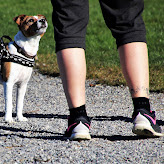1. Introduction: Understanding the Time Commitment of Dog Training
Welcome to the world of dog training, where the journey to transform
your furry companion into a well-behaved and obedient friend begins. As a
responsible dog owner, it is essential to recognize the time and effort
required to train your beloved pet. This article aims to shed light on
the duration of dog training, presenting key factors that influence its
length, various training stages, and useful tips to accelerate the
process. By understanding the time commitment involved, you can approach
dog training with realistic expectations, patience, and the right
strategies to ensure a successful and rewarding training experience.
1.1 Importance of Time Commitment in Dog Training
Training a dog is not a one-time event; it requires a commitment of time
and effort. Just like humans, dogs don't become experts overnight.
Consistency and repetition are key to successful training. So, before
you embark on the journey of training your furry friend, it's essential
to understand the time commitment involved.
1.2 Realistic Expectations for Training Duration
Now, I'm not here to burst your bubble, but let's set some realistic
expectations. The duration of dog training can vary significantly. While
some dogs may pick up commands quickly, others may take a bit longer to
grasp them. It all depends on various factors, which we'll explore in
the next section. So, buckle up and be prepared for some ups and downs
along the way!
2. Factors Influencing the Duration of Dog Training
2.1 Age and Breed Considerations
Just like humans, dogs have their own learning curves. Age and breed can
greatly influence the duration of training. Puppies, for instance, tend
to have shorter attention spans and might take longer to learn commands
compared to older dogs. Similarly, different breeds have different
levels of intelligence and predispositions, which can affect training
time. But hey, don't get discouraged - every dog can be trained; they
just learn at their own pace!
2.2 Previous Training and Socialization
Has your dog had any previous training or socialization? If so, that can
impact the training duration. Dogs with a solid foundation of basic
obedience commands may progress more quickly into advanced training,
while dogs with little to no prior training may require more time to
establish the basics. Socialization also plays a vital role here. Dogs
who are well-socialized tend to be more receptive to training, while
those lacking social skills may need extra time to adjust.
2.3 Individual Temperament and Personality Traits
Just like humans, dogs have unique personalities too. Some are eager to
please, making training a breeze, while others might be a tad more
stubborn (I'm looking at you, Fido!). The temperament of your pooch can
affect how quickly they pick up training. It's important to understand
your dog's personality traits and tailor your training approach
accordingly. Patience and understanding go a long way in dealing with
different temperaments.
3. Basic Obedience Training: Establishing a Foundation
3.1 Fundamental Commands and Skills
Before diving into advanced tricks and specialized skills, it's crucial
to establish a solid foundation of basic obedience commands. Sit, stay,
come, and leash walking are some of the essential skills every dog
should learn. These commands create the building blocks for further
training and ensure a well-behaved companion. Remember, Rome wasn't
built in a day, and neither was Lassie!
3.2 Training Techniques for Basic Obedience
When it comes to training techniques, there's no one-size-fits-all
approach. Positive reinforcement, clicker training, or even treat-based
incentives can all be effective methods. Find what works best for your
dog's learning style and personality. And please, put away those
outdated dominance-based methods. Positive reinforcement is the way
forward - it's like giving your dog a high-five for a job well done!
4. Advanced Training: Specialized Skills and Commands
4.1 Advanced Commands for Specialized Tasks
Once you've laid the groundwork with basic obedience training, you can
move on to more advanced commands. These specialized skills could
include tasks like fetching, agility training, or even tricks like
rolling over or playing dead. The possibilities are endless, and the
choice of advanced commands depends on your dog's abilities and your own
interests. Get creative and have fun with it!
4.2 Training Methods for Advanced Skills
As you venture into advanced training, you might need to explore more
specific techniques. Target training, shaping behaviors, or utilizing
props like clickers or target sticks can all be valuable tools.
Remember, advanced training requires patience and a bit of persistence.
Your dog may not become an Einstein overnight, but with consistent
practice and positive reinforcement, they can impress you with their
newfound skills!
So, there you have it - the ins and outs of dog training duration.
Remember, training is not just about teaching your dog commands; it's
about building a strong bond and fostering good behavior. Embrace the
journey, and don't forget to shower your pup with love and treats along
the way!
5. Behavioral Training: Correcting Problematic Behaviors
5.1 Identifying and Addressing Problem Behaviors
When it comes to training our furry friends, it's not just about
teaching them new tricks. We also need to address any problematic
behaviors they may have developed. Common issues like excessive barking,
chewing, or jumping can be tackled through behavioral training.
Identifying the root causes of these behaviors is the first step. Is
your dog bored, anxious, or seeking attention? Understanding why they're
engaging in these behaviors will help you develop a plan to address
them effectively.
5.2 Techniques for Behavior Modification
Once you've identified the problem behaviors, it's time to implement
behavior modification techniques. Consistency is key here! Reinforce
positive behaviors while redirecting and discouraging negative ones.
Reward-based training methods work wonders for behavior modification.
Use treats, praise, and affection to reinforce good behaviors and
discourage undesirable ones. Remember, positive reinforcement is a more
effective and humane approach than punishment.
Don't forget that behavior modification takes time. Patience and
consistency are essential as you work towards reshaping your pup's
habits. With dedication and positive reinforcement, you'll see those
problematic behaviors become a thing of the past.
6. Timeframes for Different Breeds and Individual Dogs
6.1 Understanding Breed Characteristics and Traits
It's important to acknowledge that different dog breeds have distinct
characteristics and traits that can impact their training process. Some
breeds are known for being highly intelligent and quick to learn, while
others may require a bit more time and patience.
For example, Border Collies and German Shepherds are often considered
highly trainable breeds due to their intelligence and eagerness to
please. On the other hand, certain hound breeds, like Beagles, may be
more independent and easily distracted, requiring additional time and
effort during training.
6.2 Individual Variations in Learning Speed
Just like humans, dogs have their own unique personalities and learning
styles. Some pups may pick up commands and tricks in a matter of days,
while others may take weeks or even months.
Factors such as age, prior training, and socialization experiences can
also influence a dog's learning speed. Younger dogs may have a higher
energy level and shorter attention span, which can affect their ability
to focus during training sessions.
It's important to be patient and adapt your training approach to your
individual dog. Celebrate their progress, no matter how small, and
remember that each dog learns at their own pace.
7. Training Methods and Techniques: Impact on Training Duration
7.1 Positive Reinforcement Training
Positive reinforcement training is a popular and effective method that
focuses on rewarding desired behaviors. This approach involves using
treats, praise, and affection to reinforce good behavior, while ignoring
or redirecting undesirable behavior.
Using positive reinforcement not only strengthens the bond between you
and your furry friend but also makes the training process more enjoyable
for both of you. Dogs respond well to positive reinforcement, and it
can significantly speed up their learning process.
7.2 Clicker Training
Clicker training is a specific type of positive reinforcement training
that utilizes a small device, known as a clicker, to signal the desired
behavior. The clicker acts as a marker for the exact moment your dog
performs the desired action, making it easier for them to understand
what they're being rewarded for.
Clicker training is especially helpful for precise behaviors or complex
tricks. It can enhance communication between you and your dog, leading
to faster and more efficient training sessions.
7.3 Balanced Training Approaches
Some trainers may opt for a balanced training approach that combines
positive reinforcement with mild corrections for undesired behaviors.
It's important to note that this approach should be used responsibly and
with the guidance of a professional trainer.
Balanced training can be effective for certain dogs, but it's crucial to
prioritize positive reinforcement and avoid using harsh or punitive
methods. The goal should always be to build trust and a positive
learning environment for your furry companion.
8. Tips for Accelerating the Training Process and Maintaining Progress
8.1 Consistency and Practice
Consistency is the key to successful training. Establish a regular
training schedule and stick to it. Dogs thrive on routine and
repetition, so consistent practice will reinforce their learning and
help them progress faster.
8.2 Seeking Professional Help if Needed
If you're feeling overwhelmed or struggling to train your dog, don't
hesitate to seek professional help. A qualified dog trainer can provide
guidance, assess your dog's specific needs, and offer tailored training
techniques. Sometimes, having an expert on your side can make all the
difference in achieving your training goals.
8.3 Patience and Persistence
Training any living creature takes time, and dogs are no exception.
Patience and persistence are essential throughout the training process.
Remember that setbacks and challenges are normal, but with time and
effort, you and your furry friend will make progress.
Don't forget to have fun along the way! Training should be an enjoyable
experience for both you and your dog. Embrace the journey, celebrate
achievements, and build a strong bond with your four-legged companion.In
conclusion, the time it takes to train a dog can vary based on numerous
factors, including breed, age, previous training, and individual
temperament. While there is no one-size-fits-all answer, understanding
the different stages of training, employing effective techniques, and
dedicating consistent effort and patience are crucial for achieving
desired results. Remember, dog training is a continuous process that
requires ongoing commitment and reinforcement. By investing the time and
energy into training your dog, you are not only shaping their behavior
but also strengthening the bond between you and your canine companion.
So, embrace the journey, enjoy the process, and celebrate the milestones
as you witness your dog's growth and development. Happy training!
FAQ
1. How long does it take to train a dog?
The duration of dog training can vary depending on several factors,
including the breed, age, previous training, and individual temperament
of the dog. While basic obedience training can take a few weeks to a few
months, advanced training or addressing specific behavioral issues may
require more time and ongoing reinforcement.
2. Are there any shortcuts to speed up the training process?
While there are no shortcuts in dog training, there are strategies that
can help accelerate the process. Consistency, positive reinforcement,
and clear communication play vital roles in expediting your dog's
learning. Seeking professional guidance, breaking down training tasks
into smaller steps, and providing regular practice sessions can also
contribute to faster progress.
3. Can all dog breeds be trained in the same timeframe?
No, the timeframe for training can vary among different dog breeds. Some
breeds are known for their intelligence and quick learning abilities,
which may facilitate faster training. However, it's important to
remember that each dog is unique, and individual temperament and
personality traits can also impact the training duration. Adjusting your
training approach to suit your dog's breed and individual needs is
essential for successful training.
4. What should I do if my dog is not responding well to training?
If your dog is struggling or not responding well to training, it's
important not to get discouraged. First, evaluate your training methods
and ensure they are positive, consistent, and suitable for your dog's
needs. Consider seeking guidance from a professional dog trainer or
behaviorist who can provide expert advice and tailored training
techniques. They can help identify any underlying issues and provide
customized strategies to address them effectively.





